skip to main |
skip to sidebar
 The Studio at Sydney Opera House
The Studio at Sydney Opera House
and De Quincey Co present
IMPRO-LAB: transparencies
IMPRO-LAB involves a collaboration with two legendary
Japanese artists, musician Sachiko M (Peril,
Player Piano) and vocalist Ami Yoshida with
renowned Australian artists: dancers Peter Fraser,
Yumi Umiumare, Tony Yap and Tess de Quincey
alongside musicians Jim Denley (Machine for
Making Sense) on wind instruments, Chris
Abrahams (The Necks) on keyboards, poet/vocalist
Amanda Stewart (Machine for Making Sense),
video artist Sam James and lighting designer
Clytie Smith.
Friday 24th & Saturday 25th November
at 8.15pm
The Studio
Sydney Opera House
(Entry fee :Adult $30
*Concession $25)
For more info and booking click here
On the thousand kilometre drive down the east coast's Princes Highway from Sydney to Melbourne, Victoria, as we stopped off in various places I realised that a number of contemporary poets hail from the coast. One such stop was in a dairy farming town on a wide tidal river winding into a picturesque valley of farms sheltered by a distant low range - Moruya, once the childhood home of well-known poet John Tranter, friend, poetry colleague and editor of Jacket. (John's father, a teacher, farmer and soft drink manufacturer, moved the family to Moruya when John was four years old.)
 Tourist brochure - Moruya
We stayed overnight in Bega, another dairy farming town in New South Wales, known for its cheese. A town associated, for me, with another friend, the poet and gardener Denis Gallagher who lived there for some time in the late 1970's/early 1980's. As most places in Bega closed for business around six p.m. and the pubs became disturbing sources of Indigenous peoples' loud existential arguing, we opted for dinner at the Bega RSL (Returned Servicemans' League) Club. It was a world unto itself - thick dark curtains covered every window to screen out daylight and summer's late sunsets and to affect, in fact, permanent evening. One huge room with a long bar and a glassed-in Keno booth on one end. The lurid green walls encased a square of rows of poker machines, smoking areas marked simply by a suspended sign that you step under from the non-smoking part of the room to the other, a pool competition with the usual chalk heiroglyphics on a blackboard and a traditional meat raffle in which a large number of locals participated, hoping to win trays of lamb chops, beef roasts and snags. All of this was accompanied by a cacophonous mix of sounds of the pokies, an enormous Sky channel sports screen, a juke box, the raffle caller and half-shouted conversations.
Tourist brochure - Moruya
We stayed overnight in Bega, another dairy farming town in New South Wales, known for its cheese. A town associated, for me, with another friend, the poet and gardener Denis Gallagher who lived there for some time in the late 1970's/early 1980's. As most places in Bega closed for business around six p.m. and the pubs became disturbing sources of Indigenous peoples' loud existential arguing, we opted for dinner at the Bega RSL (Returned Servicemans' League) Club. It was a world unto itself - thick dark curtains covered every window to screen out daylight and summer's late sunsets and to affect, in fact, permanent evening. One huge room with a long bar and a glassed-in Keno booth on one end. The lurid green walls encased a square of rows of poker machines, smoking areas marked simply by a suspended sign that you step under from the non-smoking part of the room to the other, a pool competition with the usual chalk heiroglyphics on a blackboard and a traditional meat raffle in which a large number of locals participated, hoping to win trays of lamb chops, beef roasts and snags. All of this was accompanied by a cacophonous mix of sounds of the pokies, an enormous Sky channel sports screen, a juke box, the raffle caller and half-shouted conversations.

 Bega RSL Club, November 2006
Further along the highway there were half a dozen ways of heading west towards a hinterland dairy farming town with the slightly comical, beautiful name of Bombala. The formative home town of two experimental poets Michael Farrell and Geraldine McKenzie. Something poetic in the cow's milk on the southern New South Wales coast ?
Crossing the border into Victoria you enter dark logging forests and soon arrive in the coastal towns of East Gippsland. Almost twenty years ago Laurie Duggan wrote a complex, poetic meta-text about Gippsland, from the dispossession of the Indigenous people during early settlement, gold digging, farming, through the years of world wars, rural industry, the Snowy River and its attendant myths and history, and so on, progressing up until the 1980's. The Ash Range compiles journals, newspaper stories, gold prospectors' and others' letters, historical photos, topographical lithographs and Duggan's notes and poems to construct a prose and poetry epic. The last poem in the book canvasses, in its final stanzas, some of the cultural ironies or clashes of 'civilization' and 'the bush' - I remember the final image of a phone booth in the middle of the bush. That book's packed away with the rest of our books and household stuff in storage in Melbourne.
Bega RSL Club, November 2006
Further along the highway there were half a dozen ways of heading west towards a hinterland dairy farming town with the slightly comical, beautiful name of Bombala. The formative home town of two experimental poets Michael Farrell and Geraldine McKenzie. Something poetic in the cow's milk on the southern New South Wales coast ?
Crossing the border into Victoria you enter dark logging forests and soon arrive in the coastal towns of East Gippsland. Almost twenty years ago Laurie Duggan wrote a complex, poetic meta-text about Gippsland, from the dispossession of the Indigenous people during early settlement, gold digging, farming, through the years of world wars, rural industry, the Snowy River and its attendant myths and history, and so on, progressing up until the 1980's. The Ash Range compiles journals, newspaper stories, gold prospectors' and others' letters, historical photos, topographical lithographs and Duggan's notes and poems to construct a prose and poetry epic. The last poem in the book canvasses, in its final stanzas, some of the cultural ironies or clashes of 'civilization' and 'the bush' - I remember the final image of a phone booth in the middle of the bush. That book's packed away with the rest of our books and household stuff in storage in Melbourne.
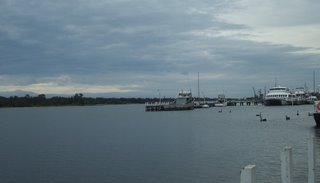 Lakes Entrance, East Gippsland, November 2006
Lakes Entrance, East Gippsland, November 2006
It seems that I'm an itinerant. I've moved around all my life - from early on, when, due to unusual circumstances, my mother, father, brother and sister took off in separate directions when I was just eighteen months old until now - and that's many years later. According to my partner Jane and her French friends, I have what they call la bougeotte - from the verb bouger - to move, or get around. La bougeotte means having the fidgets. I don't think of it this way at all - I just seem to change address fairly often. Not including various residencies overseas, and not including various addresses in the same suburbs at different times, in chronological order, these are the places I've lived :
Seymour, Victoria. Camp Hill, Brisbane. Army Base Toowoomba, Queensland. Enoggera Army Base, Gaythorne, West Chermside, Kangaroo Point, Milton, Figtree Pocket, Brisbane, Queensland. Little Bay, Paddington, Darlinghurst, Surry Hills, Sydney, New South Wales. Carlton, Melbourne, Victoria. Paddington, Surry Hills, Sydney, New South Wales. Sherbrooke Forest, Monbulk, Dandenong Mountains, Victoria. Glebe, Sydney. MacDonald Valley, New South Wales. Annandale, Rozelle, Sydney. Mountain Lagoon, New South Wales. Parkside, Adelaide, South Australia. Newtown, Petersham, Camperdown, Ultimo, Bellevue Hill, Sydney. Blackheath, New South Wales and, finally, I'll say farewell from Rose Bay, Sydney.
 Sultry morning, Rose Bay, Sydney
Sultry morning, Rose Bay, Sydney
25th October 2006
 The famous saucepan (foto courtesy AWM, Canberra)
The famous saucepan (foto courtesy AWM, Canberra)
One of the stories that Rose Bay locals like to tell concerns a Japanese submarine and the damaged aluminium saucepan. It was taken from the kitchen of the place next door to where we've lived for the last four and a half years. It was demolished by a shell from the large Japanese submarine I-24. The I-24, which had launched the midget submarine in a famous attack on Sydney Harbour a week earlier, fired ten shells into the Sydney suburbs of Bellevue Hill, Woollahra, Rose Bay and Vaucluse on the night of 7-8 June 1942. The only one of these shells to explode fell outside the Yallambee Flats on Plumer Road, Rose Bay, where it caused considerable damage. Several slight injuries were suffered by civilians, and as a result, many residents of the Eastern Suburbs of Sydney took up temporary residence in safer locations such as the Blue Mountains of NSW.  Yallambee, 3 Plumer Road, today
Yallambee, 3 Plumer Road, today
One way to enter the building at the University of Sydney that houses Badham Library, where I've worked for the past sixteen years is via the Graffiti Tunnel. I have been very fond of walking through this particular passageway and its ephemeral imagery.




 Graffiti Tunnel, University of Sydney, 2006
Graffiti Tunnel, University of Sydney, 2006
This time, we're moving south to Melbourne.  A shipping container 'Art Box', Melbourne Arts Festival, 2005
A shipping container 'Art Box', Melbourne Arts Festival, 2005
A note to visitors to The Deletions - you can click on any images that appear on the blog if you want to see them in larger sizes.

FULCRUM is proud to announce the publication of its fifth annual issue and the launch of its brand-new website.
FULCRUM: an annual of poetry and aesthetics, Number Five, 2006, edited by Philip Nikolayev and Katia Kapovich * 544 pp., perfectbound, exquisitely designed, cheaply priced * SPECIAL FEATURES: Poets and Philosophers; Poetry and Harvard in the 1920s * POETRY BY Stephen Sturgeon, Ben Mazer, Jeet Thayil, Vivek Narayanan, Glyn Maxwell, Joe Green, Landis Everson, Dan Sofaer, Billy Collins, John Tranter, Andrea Zanzotto, Don Share, Sean O Riordain, Greg Delanty, Michael Palmer, Kit Robinson, Brian Henry, Pam Brown, David Lehman, John Hennessy, Charles Bernstein, Charles Baudelaire, Guillaume Apollinaire, Carlos Drummond de Andrade, Arthur Rimbaud, X.J. Kennedy, John Crowe Ransom, Alex To, Fiona Sampson, Fan Ogilvie, Richard Fein, Joyelle McSweeney, Justin Marks, Gerard Malanga, Alexei Tsvetkov, George Bilgere, John Wheelwright, Malcolm Cowley, R.P. Blackmur, Dudley Fitts... * ESSAYS BY Eliot Weinberger, Peter H. Hare, Simon Critchley, Marjorie Perloff, Lisa Goldfarb, Pierre Joris, Raymond Barfield... * ART Esther Pullman, e.e. cummings * INTERVIEW: Andrea Zanzotto * ...AND MUCH MORE!

Kate Richards' and Sarah Waterson's
'sub_scapePROOF - a machinima'
is in SynCity
a survey show of dlux greatest hits!
Opening 6 - 8pm
Friday 20th October
australian centre for photography
257 Oxford Street
Paddington, Sydney
Exhibition runs 21st Oct til 26th Nov
Tues-Fri 12md - 7pm
Sat-Sun 10am - 6pm
 A & B, frisky
A & B, frisky
Spring
foyer's cat-sprayed dado walls
welcome mat in tatters
a neighbour announces
the first cockroach
of spring
fresh southerly change
chance of a shower
tell the dirty sacred ibis
feasting on boutique rubbish
from the skip
behind the Italian deli
to wing it
oddly elegiac
turning on the variety show's
latest episode
garden power reigns supreme
blue collar sensibilities
fill each fresh poem
and minds meet

In October 2001, over 400 asylum-seekers departed from Indonesia in a grossly overcrowded, unseaworthy boat bound for Australia. Somewhere between the two countries the boat sank, with a terrible loss of life. 353 of the asylum-seekers drowned.The boat was known as the SIEV X.
The Australian government claimed it had no prior knowledge of the unfolding tragedy. Yet, from the beginning, government ministers and senior officials tried to mislead the Australian Senate and the community over important questions. What did the government and its agencies know about the boat and its fate, and when did they know? Did they have or should they have taken any responsibility for the tragedy? Did they have a duty of care that they shirked ?
This weekend a public memorial will be held in the Australian Capital Canberra to mark the fifth anniversary of this tragic incident:
Siev X Memorial Ceremony and Raising of the Poles
Weston Park
Yarralumla
Canberra
2 pm Sunday 15 October 2006
Ex- Australian-ambassador to Cambodia and Poland, Tony Kevin wrote an investigative book about the sinking of the SIEV X - A Certain Maritime Incident, published by Scribe in 2004. The book revealed a disquieting record of government misconduct, including Australian Federal Police involvement in a people-smuggling 'disruption program', and an extraordinary combination of stone-walling and professed ignorance by a government dedicated to micro-managing the deterrence of asylum-seeker voyages.
Many of the victims of this disaster have family members living in Australia on temporary protection visas. This book is dedicated to them. It is also for the rest of us because, Tony Kevin argues, nothing less than a comprehensive judicial enquiry into the sinking of SIEV X will suffice if Australia is to regain its national honour.

Tony Kevin retired from the Department of Foreign Affairs and Trade in 1998, after a thirty-year public service career. He served in the Prime Minister's Department, and was Australia's ambassador to Poland and Cambodia. He is currently an honorary visiting fellow at the ANU Research School of Pacific and Asian Studies. He has written extensively on Australian foreign, national security and refugee policies in Australia's national print media, including Eureka Street, Canberra Times, the Age, Sydney Morning Herald, the Australian, and Australian Financial Review.
He has also recently written a critique of the proposed Australian Values and English Test that Sylvia Lawson also covered recently - blogged here on The Deletions.
A letter to the editor of The Sydney Morning Herald Newspaper on this topic was published yesterday :
Language test for immigrants is a smokescreen
(October 13, 2006)
I write concerning the proposal that immigrants must speak English.
A language test on immigrants harks back to the dark days of white supremacy in Australia, and the test will prove absolutely nothing about immigrants' ability to integrate.
One of my happiest days in the Australian foreign service was December 5, 1972, with the end of the White Australia Policy.
To that time the Australian government excluded non-white immigrants by testing them in a language they did not know.
I have lived in non-English-speaking countries and understand how hard it is for the first generation of immigrants to operate in a second language. As any immigrant family will tell you, it is the second generation who become the native speakers of English, while all are part of the community in their own way.
My wife is an immigrant who speaks English. She has degrees in French, Russian and Chinese literature from the University of Michigan, University of California, Berkeley, and the Sorbonne.
She has more letters after her name than are in her name. You would think she is the sort of well-educated person Australia would welcome. However, her Australian experience was hellish. She wanted to integrate, but Australians, by and large, would not allow that.
That said, she and I made many dear Australian friends, but because of the attitude of the community at large, we prefer to stay out of Australia and make the occasional return trip to see friends and family.
My wife and I have become expatriates not because her language skills did not allow her to integrate and take on Australian values but because the pure merinos, the Australian-born Australians, were so uniformly hostile to her.
Is Australia ready for well-educated, white-collar immigrants? Are Australians ready to compete with them for jobs?
If not, how does Australia hope to allow them to make a life for themselves in Australia? Will these well-educated, English-speaking immigrants be satisfied making beds in hotels and serving in fish-and-chip shops?
The matter of English testing falls in the field of language policy and this debate needs to be informed by experts in that field.
The English language test is a smokescreen. In our experience the real problemf for immigrants trying to integrate into Australian society is the Australians, who are denying the values of those who seek to live there.
Geoffrey Thomas, Kinshasa, Democratic Republic of Congo
 Immigration Minister, Amanda Vanstone, Attorney General, Philip 'Mr. Burns' Ruddock by Paul Batey In Australia as the government moves so far to the right of what was once right that they now believe they're dead right, we're talking about the Foreign Minister ticking off politicians in the Solomon Islands, about North Korea, about Indonesia, about a national education curriculum to save us from pinko red lefty ideologues and we're talking about state-sanctioned racism in the form of English language tests for migrants (the revenants of the White Australia Policy still haunt us)
Immigration Minister, Amanda Vanstone, Attorney General, Philip 'Mr. Burns' Ruddock by Paul Batey In Australia as the government moves so far to the right of what was once right that they now believe they're dead right, we're talking about the Foreign Minister ticking off politicians in the Solomon Islands, about North Korea, about Indonesia, about a national education curriculum to save us from pinko red lefty ideologues and we're talking about state-sanctioned racism in the form of English language tests for migrants (the revenants of the White Australia Policy still haunt us)
Sydney-based Sylvia Lawson writes essays, journalism and fiction. Her most recent book is The Outside Story (Hardie Grant, 2003), a novel centred on the contested history of the Sydney Opera House.The Archibald Paradox her multi-award-winning study of the early Sydney Bulletin and its first editor, is out in a new edition from The Miegunyah Press.
She has written an article on this current issue for The New Matilda in agreeable response to an earlier article by Emma Dawson.
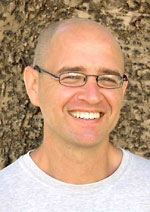 Michael Farrell (foto Nandi Chinna)
Michael Farrell (foto Nandi Chinna)
Melbourne poet, Michael Farrell has just published Break Me Ouch an A4 sized book of poetry comics . It's nutty, witty, funny and occasionally thoughtful too.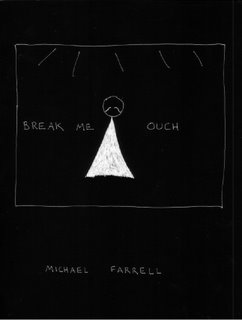

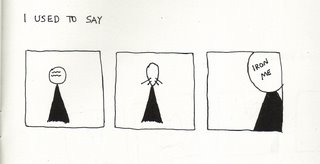 It's published by
It's published by
3 Deep Publishing
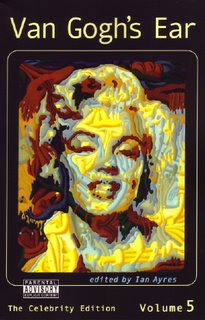
Van Gogh's Ear 5: The Celebrity Edition
Van Gogh's Ear is an international anthology series based in Paris, France and published in conjunction with Allen Ginsberg's Committee on Poetry in New York City. Since its début in 2002, Van Gogh's Ear has gained considerable acclaim for its eclecticism and publishing such legends as Marilyn Monroe, James Dean, Yoko Ono, Tony Curtis, Xaviera Hollander, Charles Manson, and a great many more, alongside renowned poets, novelists, political activists, and never-before-heard voices from every walk of life in all parts of the world. Van Gogh's Ear is distributed in the United States, Canada, Europe, South Africa, and Australia.
The editor, Ian Ayres, describes the new issue : Van Gogh's Ear: The Celebrity Edition, which is volume 5, celebrates art, poetry, and the ultimate sex goddess of the 20th century, Marilyn Monroe. There's a one-act play by Joyce Carol Oates that brings to life Marilyn's posing for the nude calendar shot, new insights from Marilyn biographer Sarah Churchwell, plus never-before-revealed Marilyn memories by her personal masseur, Ralph Roberts, friend John Gilmore, and others who actually knew her. More exciting highlights are memoirs by movie stars and celebrities such as Tony Curtis, Mamie Van Doren, Sylvia Miles, and Xaviera Hollander. Not to mention the many renowned poets, novelists, cultural icons and political activists also included in this truly international collection with contributors from Australia, India, Dubai, Italy, Spain, South Africa, Canada, the USA, Ireland, England, France, Holland, Germany, Finland, Serbia, etc. Volume 5 of Van Gogh's Ear addresses taboo, politics and the human condition from every walk of life. Plus there's a compelling letter from Patricia Nell Warren, author of best-selling novel The Front Runner , in which she warns about the negation of free speech and the rise of fascism in the USA. And a scan of a recent prison letter from Charles Manson, in which he expresses concern about what's happening to the planet, tells of how he's treated in prison, as well as how he feels about his fame and the exploitation of him in the music scene. Volume 5 is an odyssey through cultural landscapes, revealing more about our times than any internet news-source or guru ever has. Exhibiting paintings that honor the life and times of Marilyn Monroe by such artists as Demetrie Kabbaz, Werner Horvath, and Tony Curtis, this collection is a must for Marilyn fans everywhere. Due to nudes, however, along with explicit works by the world's most daring writers, i.e., the Marquis de Sade, a 'Parental Advisory' warning appears on the cover.
My copy was opened for inspection by Australian officials. 
Featured Contributors:
Franklin Abbot Shane Allison Antler Jorge Artajo Joe Bacal
Dawn-Michelle Baude Barbara Beck Guy R. Beining
Kimberly Biggers Gojko Bozovic J. R. Brady Rolf Dieter Brinkman
Pam Brown Michael Brownstein Peter Cherney Sarah Churchwell
Billy Collins Dennis Cooper Barbara Costa Holly Crawford
Quentin Crisp Tony Curtis William Curtis Jen Dalton
Albert Flynn DeSilver DML Eduard Escoffet Landis Everson
Marcus Ewert Marilyn Yvonne Ford Serge Gainsbourg
Maureen Gallagher Johnny Gevalia John Gilmore John Giorno
Daphne Gottlieb Stephen Gray J. Kenneth Grider Andreas Gripp
Jane Hathaway Michael Hathaway Trebor Healey
Thomas M. Herndon Lynette S'phiwe Hlongwane
Xaviera Hollander Paul Hoover Werner Horvath Justice Howard
Gary Indiana Fred Johnston Demetrie Kabbaz Kit Kennedy
Romella D'Ore Kitchens John Kliphan Aki Lehtinen
Linda Lerner J. T. LeRoy Lyn Lifshin Jason Lynn Jayanta Mahapatra
Norman Mailer Charles Manson Lori A. May Ben Mazer
Gabrielle McIntire Sharon Mesmer Robin Metz Sylvia Miles
Peter Minter Pete Mullineaux Eileen Myles Thom Nickels
Joyce Carol Oates Ulick O'Connor Molly Peacock
Daniel Pendergrass Robert Peters Felice Picano Jane Piirto
Jennifer Pinard Wayne Ray Dee Rimbaud Ralph Roberts
Bob Rosenthal Lauren Russell Albert Russo Marquis de Sade
Aram Saroyan Richard Siken Mark Terrill Paul Trachtenberg
John Updike Mamie Van Doren Phillip Ward Patricia Nell Warren
Lewis Warsh Regina Weinreich Janean Williams A. D. Winans
Saint James Harris Wood Jeffrey Cyphers Wright Gerald Zipper
It's available from French Connection Press
 (foto - Sharon Harris)
(foto - Sharon Harris)
Christian Bök (born Book in Toronto 1966) is a Canadian experimental poet. He is a sound poet best known for holding the world record of the fastest rendition of Kurt Schwitters' Ursonate. He performed this double-speed live on WFMU Radio, New York, where he also performed other compositions derived from made-up languages used for Canadian science fiction shows.
Eunoia is probably the work for which he is most famous. Edited by Darren Wershler-Henry at Coach House Books, Eunoia is a lipogram that uses only one vowel in each of its five chapters, and this work was a bestseller in Canada and won the Griffin Poetry Prize in 2002. One of its sections is chapter e for René Crevel.
'Vowels', a poem that appears in Eunoia was featured in the lyrics of a song on the EP 'A Quick Fix of Melancholy' by the Norwegian rock band 'Ulver' in 2003. Bök is also the author of Crystallography (Coach House Books, 1994), a pataphysical encyclopedia. He has created conceptual art, making artist's books from Rubik's cubes and Lego bricks. Bök is a Ph.D. graduate from York University in Toronto. He teaches at the University of Calgary. He has also worked in sci-fi television, designing artificial languages for Gene Roddenberry's Earth: Final Conflict and Peter Benchley's Amazon. He lives in Calgary.
Christian Bök's publications:
Crystallography (1994) ISBN 1552451194
Eunoia (2001) ISBN 1933368152
Pataphysics: The Poetics of an Imaginary Science (2002)
ISBN 0810118777
The Cyborg Opera (forthcoming)
Christian Bök will be presenting his work
at UTS this Tuesday afternoon
Tuesday October 3 5pm
UTS Building 6 (Design and Architecture Building),
Level 3, Room 21
Enter from Harris Street steps
beneath the pedestrian bridge.
Free entry, all welcome.
Steve Evans' annual survey of what poets are reading,
Attention Span has been released for 2006. Steve Evans - a rose is a rose is a rrose
Steve Evans - a rose is a rose is a rrose
Steve Evans is Associate Professor of English at the University of Maine, where he teaches courses on critical theory, poetry and poetics, and the avant-garde. He coordinates the New Writing Series, is a contributing editor for The Poker and tends Third Factory website.
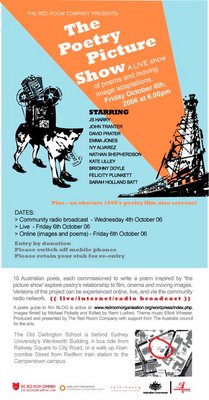 The Poetry Picture Show
The Poetry Picture Show
poems on films, films on poems
with JS Harry, John Tranter,
Kate Lilley, David Prater & others
one night only :
FRIDAY OCTOBER 6th
At 6pm
Old Darlington School
University of Sydney
(entry by donation)
 Eurobeat the ridiculously funny, musical send-up of the annual Eurovision Song Contest is currently playing at the State Theatre in Sydney. Coincidentally, it stars the gorgeous daughter of my blended family, Julia Zemiro.
Eurobeat the ridiculously funny, musical send-up of the annual Eurovision Song Contest is currently playing at the State Theatre in Sydney. Coincidentally, it stars the gorgeous daughter of my blended family, Julia Zemiro.
Sometimes, I'm hard to please, I hardly ever go to musical theatre, generally find self-described comedy unfunny, but I laughed throughout this entirely upbeat, hoot of a show. Book through Ticketmaster.

The Lost Echo
directed by Barrie Kosky co-written with Tom Wright
12 stories of love, lust, madness and revenge
38 of Australia's finest performers
8 hours experienced in two parts.
The Lost Echo is about how the world, human beings and nature are all in a constant of flux and change.
It's about how we love. How passions change us. It's about how desire can destroy.
Based on Ovid's Metamorphoses, The Lost Echo is a kaleidoscope of music, text, dance, and image using the music of Cole Porter, John Dowland and Franz Schubert.
I have seen Part One – four hours of crazy, intense, marvelous theatre and have booked my ticket for Part Two.
At the Sydney Theatre Company
Hickson Road, Walsh Bay
Part Two began with the gruelling tale of The Bacchae ('The Song of Bacchus' -isn't that Euripides, not Ovid ?) and the the demise of Pentheus, dismembered and cannibalised by the female followers of Bacchus, his head is returned to Cadmus by an incredibly demented Agave. All this godly gore and human misery performed in an over-sized urban male washroom and toilet.
'The Lost Echo' concluded with 'The Song of Orpheus' interpreted, incredibly, via Franz Schubert's song cycle 'Die Winterreise' (The Winter Journey). All ultra camp, amazingly choreographed, burlesque, kitsch, post modern, pop, funk (snatches of 'Blame It on The Boogie' accompanied by action freezes) and classical. The theatre Barrie Kosky makes, to use an old cliche, defies description. It is stunning. It is THEATRE.
'The Lost Echo' closes tonight, Saturday 30th September.
NEW READING SERIES IN ADELAIDE
THE LEE MARVIN READINGS :
at Gallery de la Catessen:
9 Anster St., off Waymouth
Adelaide, South Australia
Mondays 7.30 for 8PM
Price $5
10th Reading October 2
: LEE MARVIN ON THE LAM :
Jordan D'Arsie
Kerryn Goldsworthy
Ashley Graetz
Bern Smith
Naomi Horridge
11th Reading October 9
:LEE MARVIN IN AN ETUDE BLUE :
Peter Rose
Stephen Lawrence
Moya Costello
Paul Hoban
Andrea Jorss
12th Reading October 16
:LEE MARVIN IN AN ETUDE BLEU :
Stephen Whittington
John Jenkins
Linda Marie Walker
Shannon Burns
Carol Lefevre
13th Reading October 23
: LEE MARVIN IN A BROWN STUDY :
Ken Bolton
Jordan D'Arsie
Tracy Crisp
Miriel Lenore
Teri Hoskin
14th Reading October 30
: LEE MARVIN ON A BENDER :
Bel Schenk
Heather Johnson
Cath Kenneally
Khail Jureidini
Steve Evans (not the U.S. Steve Evans)
Mark Young has sent me a copy of a poetry pamphlet from the mid–70's Patterns series. Mark's poem is an emulation of Arthur Rimbaud. The cover drawing is by Sasha (who also had a poem published in the series).

Over a period of time in the late 1990's, Sasha sent a group of self-portraits to Nicholas Pounder.
In Hanoi
While the United States Of America's punitive embargo on Vietnam was still in place and the internal process of doi moi had begun as a 'renovation' of Vietnamese society (something like Mikhail Gorbachev's 'glas nost' program in the USSR), I travelled to Hanoi to visit a friend, Sue Howe, who had been living there for some time, working as a teacher at the University for Foreign Languages, sponsored by Australian Aid Abroad. Sue obtained an invitation from the Ministry of Education for me to conduct some classes in English on Australian poetry – that was the only way to get a visa in those days. Not long after I'd arrived in Hanoi in the north, Sasha landed in Ho Chi Minh City, in the south. About a week later and with (miraculously) only one minor scrape with the authorities to report, he joined us in the Giang Vo flats.
 Giang Vo, 1991We met the very hospitable staff at the Vietnamese Womens Publishing House and spent time with the poet Nguyen Thi Hong, and we also visited the official Writers Association.
Giang Vo, 1991We met the very hospitable staff at the Vietnamese Womens Publishing House and spent time with the poet Nguyen Thi Hong, and we also visited the official Writers Association.
At the time, these groups were extremely impoverished and did not have access to western writing apart from occasional magazines like 'Time', brought in to Hanoi by NGO workers, and Colleen McCullough's 'The Thorn Birds' and some Shakespeare – both of which had been translated into Vietnamese from English via Russian and had become new versions of the original texts. Both groups gave us lists of books they would like us to send from Australia.
On my return to Sydney, I organised a benefit reading at 'Writers in the Park' at the Harold Park Hotel in Glebe to raise money to buy books for the Vietnamese writers. Tom Thompson, then the publisher at Angus & Robertson donated a box of the Australian classics and modern poets he was publishing. I bought the books, packaged them up and then tried to get the Department of Foreign Affairs to freight them up to Hanoi. Of course, even with contacts in the Australian embassy, including the Ambassador to Vietnam, the department in Canberra refused assistance. Around that time, Sasha had decided to travel to Moscow and was heading up via Hanoi. He carted the boxes of books off with him, with some cash to pay for excess baggage.
 Hoa (translator), Vu Tu Nam, Vietnam Writers Association – Sasha, delivering the books Some years later (I think in 1997 when Sasha was returning to Vietnam for an AsiaLink residency) he claimed, in his inimitable manner, in the pages of the Australian Book Review to have been solely responsible for my altruistic project - an undertaking that had taken considerable time and energy to co–ordinate. Subsequently, Sasha and I engaged in a minor public stoush in the correspondence pages of the magazine. Sasha had a way of bragging about 'his' radicalisms that was sometimes unthinking. Of course, after a couple of months silence, we reconciled. And just now, when I looked for copies of that correspondence I seem to have mislaid it. (Although it can probably be found in the Mitchell Library archive).
Hoa (translator), Vu Tu Nam, Vietnam Writers Association – Sasha, delivering the books Some years later (I think in 1997 when Sasha was returning to Vietnam for an AsiaLink residency) he claimed, in his inimitable manner, in the pages of the Australian Book Review to have been solely responsible for my altruistic project - an undertaking that had taken considerable time and energy to co–ordinate. Subsequently, Sasha and I engaged in a minor public stoush in the correspondence pages of the magazine. Sasha had a way of bragging about 'his' radicalisms that was sometimes unthinking. Of course, after a couple of months silence, we reconciled. And just now, when I looked for copies of that correspondence I seem to have mislaid it. (Although it can probably be found in the Mitchell Library archive). Sasha Soldatow 2005
Sasha Soldatow 2005
 Sasha Soltadow, choked by the bureaucracy, in his Special Broadcasting Service editing booth, mid 1980s In 1983, before homosexuality was legalised in New South Wales, the Oxford Street gay bar, Club 80 was raided by police. There was a shocked reaction from people who frequented the bars and saunas. Sasha Soldatow produced a pamphlet that was critical of the response. It provides an important historical analysis of the early history of the Sydney Gay Mardi Gras, and the pursuit of the gay dollar to the detriment of the development of sexual politics which broadly challenges the power relationships in society. You can read What Is This Gay Community Shit? here on Takver's site. (It includes Sasha's commentary on the pamphlet from 2001.)
Sasha Soltadow, choked by the bureaucracy, in his Special Broadcasting Service editing booth, mid 1980s In 1983, before homosexuality was legalised in New South Wales, the Oxford Street gay bar, Club 80 was raided by police. There was a shocked reaction from people who frequented the bars and saunas. Sasha Soldatow produced a pamphlet that was critical of the response. It provides an important historical analysis of the early history of the Sydney Gay Mardi Gras, and the pursuit of the gay dollar to the detriment of the development of sexual politics which broadly challenges the power relationships in society. You can read What Is This Gay Community Shit? here on Takver's site. (It includes Sasha's commentary on the pamphlet from 2001.)
Takver, who first met Sasha in 1974, last saw him at an Anarchist and Autonomist Gathering at Melbourne University in 2001. Over several months during that year they worked on updating notes on the pamphlet and on Sasha's biographical material on the neglected Australian poet Harry Hooton, whose Poet of the 21st Century : Collected Poems Sasha edited for Angus & Robertson publishers in 1990. 'Be realistic – demand the impossible'. Slogan from walls of the Sorbonne, Paris, May 1968
'Be realistic – demand the impossible'. Slogan from walls of the Sorbonne, Paris, May 1968
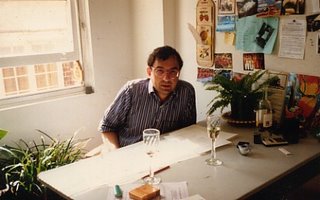 Sasha working on a filmscript for filmmaker, Margot Nash, at her flat in Coogee, Sydney (foto: Margot Nash)
Sasha working on a filmscript for filmmaker, Margot Nash, at her flat in Coogee, Sydney (foto: Margot Nash)
There are so many things you could say about Sasha.
There are so many people who could say something.
I hope I can include at least some of those things now.
Sasha was a one-off.
He was a romantic.
He was a hedonist.
I loved him for his inventiveness, his wit and his daring lack of concern for limits. He believed in an anarchic philosophy that could set people free, he certainly wanted that and acted that way, boundlessly. He followed the anarchist adage from the graffiti of 1968 'Be realistic - demand the impossible '.
It was fun and a bit risky to get around with Sasha. I have a strong moral streak that compels me to loathe hypocrisy, calumny and, well, in general, smooth explaining. But I'd credit Sasha with showing me how to laugh at peoples' foibles and jealousies rather than judging them and also how to laugh at life's absurdities.
He was forgiving and generous.
He liked to get drunk and play powerful music that nobody could resist. Especially at two in the morning.
He could also be a terrible nuisance - like an ant in your warm and comfortable armpit.
He liked to rock the boat. He lived in harm's way.
He was an original kind of troublemaker.
I know that in the years of our friendship, that Sasha was sometimes 'too much' for his friends and 'too much' for me too but I have not one, not even a smidgin of regret.
He was a founding member of several ephemeral but spirited mini-movements like 'Drink Against Drunkenness'. He and I founded 'The Bon Mot Gang' - our motto was 'we're always funny'. We had a membership of three dedicated and others floating.
I remember the pleasure, the actual fun of making performances with Sasha - Percy Grainger and his Whips at The Performance Space, in Sydney, with Elizabeth Drake. Some of you will remember his Tin Sheds show The Adventures of Rock'n' Roll Sally: A Burlesque, an ongoing work, that he repeated in various versions for Pride Week shows at the Gay Community Centre in Holt Street Surry Hills, and in Miss The Opera Lights with Elizabeth, & Amanda Stewart & myself at The Gap Cabaret in Surry Hills and later in the Writers Week Tent at the Adelaide festival.

Rock'n'Roll Sally: A Burlesque (Sasha as Marilyn)
Poster by Chips Mackinolty
Together we read and changed and re-read the pieces for his first book of fiction Private Do Not Open until it was ready for publication. We edited an edition of Cargo magazine together for the gay press, Blackwattle. He was the editor of The Only Sensible News.
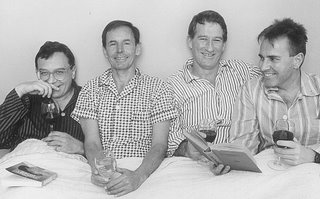
Sasha, Ian MacNeill, Denis Gallagher, Gary Dunne - Blackwattle authors. 1990 (foto: William Yang)
Sasha was almost-permanently translating the great Russian poet Anna Ahkmatova because, according to him everyone else was getting it wrong. Richard Mills set Sasha's translation of her long poem Requiem to music and the piece was performed at The Sydney Opera House in 2005.
He was a talented writer but, really, that extra and required dose of perseverance was, puzzlingly, wanting in Sasha. Writing is a solitary task and Sasha was gregarious and hospitable. I think Sasha would always prefer a crowded party in honour of a newly-acquired washing machine to a few hours of torture of the back and bum alone at the writing table.
Sasha's quick temperament and attention span was better suited to painting watercolours and making collages , which he also did. And on piano he played his famous 'Mozart in a Minute'.
Sasha was an eclectic collector - he had the famous ticket collection (part of which is held in the National Gallery in Canberra), innumerable interesting pencils, coloured lead seals from the tops of wine bottles and a marvellous collection of burnt & broken matchsticks.
Sasha liked the details. When you went mushrooming with Sasha he'd refer to the Fungi species chart before deciding whether to actually pick that mushroom or toadstool - then later, in the kitchen, he'd cook up the rarest and most evil-looking ones and even the utterly sceptical diner survived the meal.
He loved plants, plants in gardens, plants in the bush, he loved and respected weeds.
There are white pelargoniums growing in various locations from Sydney to Blackheath to who-knows-where from a cutting from Park Parade, Bondi that Sash gave me.
Sasha always reckoned that if you had poor eyesight your sight would be restored at the moment of your death. I hope he was right.
Ah Sasha
Dasvidanya Sasha, spasiba Twenty Years Ago - Xmas Day
Twenty Years Ago - Xmas Day
Some books by Sasha Soldatow:


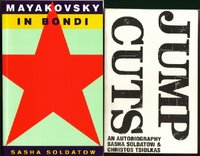 click on the image for larger format
click on the image for larger format









 Tourist brochure - Moruya
We stayed overnight in Bega, another dairy farming town in New South Wales, known for its cheese. A town associated, for me, with another friend, the poet and gardener Denis Gallagher who lived there for some time in the late 1970's/early 1980's. As most places in Bega closed for business around six p.m. and the pubs became disturbing sources of Indigenous peoples' loud existential arguing, we opted for dinner at the Bega RSL (Returned Servicemans' League) Club. It was a world unto itself - thick dark curtains covered every window to screen out daylight and summer's late sunsets and to affect, in fact, permanent evening. One huge room with a long bar and a glassed-in Keno booth on one end. The lurid green walls encased a square of rows of poker machines, smoking areas marked simply by a suspended sign that you step under from the non-smoking part of the room to the other, a pool competition with the usual chalk heiroglyphics on a blackboard and a traditional meat raffle in which a large number of locals participated, hoping to win trays of lamb chops, beef roasts and snags. All of this was accompanied by a cacophonous mix of sounds of the pokies, an enormous Sky channel sports screen, a juke box, the raffle caller and half-shouted conversations.
Tourist brochure - Moruya
We stayed overnight in Bega, another dairy farming town in New South Wales, known for its cheese. A town associated, for me, with another friend, the poet and gardener Denis Gallagher who lived there for some time in the late 1970's/early 1980's. As most places in Bega closed for business around six p.m. and the pubs became disturbing sources of Indigenous peoples' loud existential arguing, we opted for dinner at the Bega RSL (Returned Servicemans' League) Club. It was a world unto itself - thick dark curtains covered every window to screen out daylight and summer's late sunsets and to affect, in fact, permanent evening. One huge room with a long bar and a glassed-in Keno booth on one end. The lurid green walls encased a square of rows of poker machines, smoking areas marked simply by a suspended sign that you step under from the non-smoking part of the room to the other, a pool competition with the usual chalk heiroglyphics on a blackboard and a traditional meat raffle in which a large number of locals participated, hoping to win trays of lamb chops, beef roasts and snags. All of this was accompanied by a cacophonous mix of sounds of the pokies, an enormous Sky channel sports screen, a juke box, the raffle caller and half-shouted conversations.

 Bega RSL Club, November 2006
Further along the highway there were half a dozen ways of heading west towards a hinterland dairy farming town with the slightly comical, beautiful name of Bombala. The formative home town of two experimental poets Michael Farrell and Geraldine McKenzie. Something poetic in the cow's milk on the southern New South Wales coast ?
Crossing the border into Victoria you enter dark logging forests and soon arrive in the coastal towns of East Gippsland. Almost twenty years ago Laurie Duggan wrote a complex, poetic meta-text about Gippsland, from the dispossession of the Indigenous people during early settlement, gold digging, farming, through the years of world wars, rural industry, the Snowy River and its attendant myths and history, and so on, progressing up until the 1980's. The Ash Range compiles journals, newspaper stories, gold prospectors' and others' letters, historical photos, topographical lithographs and Duggan's notes and poems to construct a prose and poetry epic. The last poem in the book canvasses, in its final stanzas, some of the cultural ironies or clashes of 'civilization' and 'the bush' - I remember the final image of a phone booth in the middle of the bush. That book's packed away with the rest of our books and household stuff in storage in Melbourne.
Bega RSL Club, November 2006
Further along the highway there were half a dozen ways of heading west towards a hinterland dairy farming town with the slightly comical, beautiful name of Bombala. The formative home town of two experimental poets Michael Farrell and Geraldine McKenzie. Something poetic in the cow's milk on the southern New South Wales coast ?
Crossing the border into Victoria you enter dark logging forests and soon arrive in the coastal towns of East Gippsland. Almost twenty years ago Laurie Duggan wrote a complex, poetic meta-text about Gippsland, from the dispossession of the Indigenous people during early settlement, gold digging, farming, through the years of world wars, rural industry, the Snowy River and its attendant myths and history, and so on, progressing up until the 1980's. The Ash Range compiles journals, newspaper stories, gold prospectors' and others' letters, historical photos, topographical lithographs and Duggan's notes and poems to construct a prose and poetry epic. The last poem in the book canvasses, in its final stanzas, some of the cultural ironies or clashes of 'civilization' and 'the bush' - I remember the final image of a phone booth in the middle of the bush. That book's packed away with the rest of our books and household stuff in storage in Melbourne.
 Lakes Entrance, East Gippsland, November 2006
Lakes Entrance, East Gippsland, November 2006























 (foto - Sharon Harris)
(foto - Sharon Harris)


















